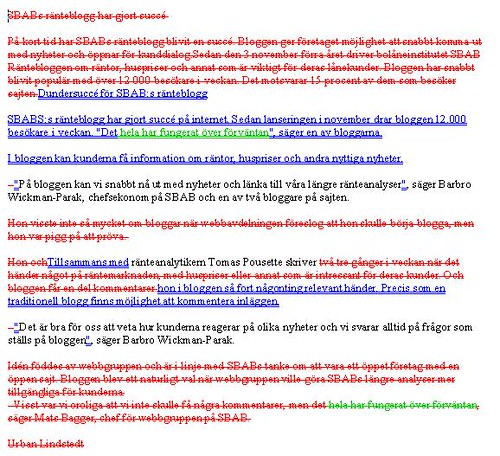Swedish journalist Alexandra Pascalidou, who recently was accused of using a ghost writer, is now being accused of plagiarism by marketing weekly Resumé. A column she wrote in Metro on 29 Dec, 2003 is strikingly similar to an article by Daniel Hernandez, which was published in LA Times and the Boston Globe two days prior (Dates according to Resumé. I have not been able to verify the date in LA Times). The two articles are indeed very similar to each other.

But is it just Pascalidou who cuts corners among journalists or is this a behaviour that is a common and “justified” means of getting things done in journalism? Let’s check an article by Magnus Helander, the journalist at Resumé who exposed Pascalidou.
Helander wrote an article on 4 Oct this year about a successful blog ad campaign from Audi, citing Online Media Daily as source. But 8 hours before Helander’s article appears online, an almost identical article (no longer online, 2011) was published by Urban Lindstedt at Internetworld. Phrases in bold are from Internetworld, phrases below are from Resumé [exact order may not entirely match the full articles].
Audi la en halv procent av annonsbudgeten i en kampanj för att köpa annonser hos större bloggar.
Audi lade en halv procent av sin annonsbudget på att köpa annonsplatser på bloggar.
Denna halva procent generade 29 procent av trafiken.
Resultatet blev en succé.
Bloggannonseringen genererade 29 procent av trafiken till biltillverkarens kampanjsajt.
Audi spenderade en halv procent av sin annonsbudget på bloggannonser på stora amerikanska bloggar när kampanjen “The Art of Heist” skulle lanseras.
Audi ville driva trafik till sin nya hemsida för kampanjen “The Art of Heist”.
I slutändan genererade bloggannonserna 29 procent av trafiken till kampanjsajten, enligt Brian Clark, vd på GMD Studios.
Enligt Brian Clark, vd på GMD Studios, drev bloggannonserna 29 procent av trafiken till kampanjsajten, uppger Online Media Daily.
Men många annonsörer är tveksamma till att annonsera på bloggar på grund av risken att de får negativa kommentarer på bloggarna.
Många potentiella bloggannonsörer uppges vara rädda för att utsättas för negativa kommenterer på bloggarna.
Men Clarke menar att annonsörer inte har råd att ignorera bloggannonser.
Men enligt Brian Clark har annonsörer inte råd att ignorera bloggannonsering.
– Om du är rädd vad användare ska säga finns det två strategier: Bli involverad i diskussionen, eller stoppa fingrarna i öronen och låtsas att den inte existerar, säger Brian Clarke till Online Media Daily. Folk pratar om dig vare sig du lyssnar eller inte.
– Om du är rädd vad användarna ska säga finns det två strategier: bli involverad i diskussionen, eller stoppa fingrarna i öronen och låtsas att den inte existerar. Folk pratar om dig vare sig du lyssnar eller inte, säger Clark till Online Media Daily.
It is quite unlikely that both Helander and Lindstedt, independent of each other, on the same day came up with the same idea to write about this story that was originally published 29 September. And decided to quote the exact same paragraphs from the article. From the looks of it, this is a poor re-write of a re-write.
Not that it matters a lot in this incident, but I strongly suspect they (read Lindstedt) got the idea from this post on my blog, the day before their articles appeared online. In my short post I linked to Davenetics where I found the story. And if you look carefully you see that I managed to nick a sentence from Davenetics, so we are all plagiarists to some extent, are we not? To my defence, at least I (and most bloggers) link to the original.
Either way, plagiarism can’t be tolerated in journalism. It is lazy and it is cheating.

